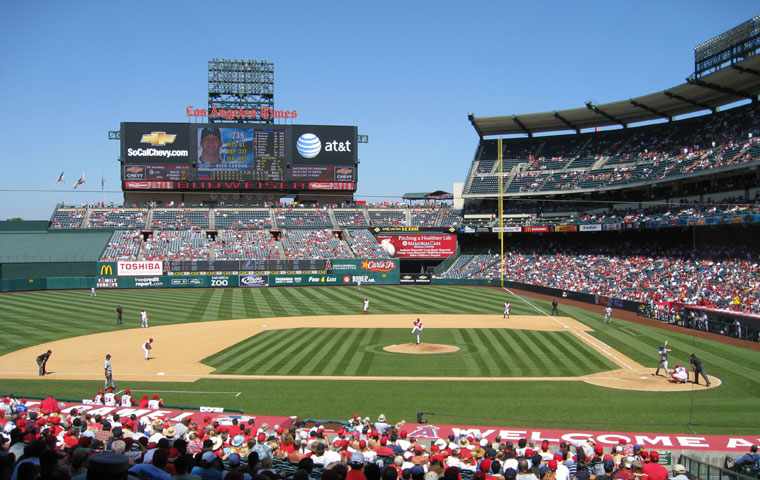
|
The Angels renaissance to the upper echelon of Major League Baseball began with the complete renovation of their ballpark in Anaheim.
Anaheim Stadium opened as a baseball-only facility in 1966, but morphed into a multipurpose stadium in 1980 to lure the NFL's Rams away from the Los Angeles Coliseum. When the Rams left for St. Louis in 1995, city officials and Angels ownership devised a plan to return the stadium to its baseball-only roots (at almost five times the cost of original construction). With the aid of famed ballpark architectural firm HOK Sport, the downsized and redesigned stadium, christened as Edison International Field of Anaheim, was ready by Opening Day in 1998. Renovations, which included the removal of 20,000 seats in the outfield that had enclosed the stadium, gave the three decades old venue a new life. An enhanced main entrance plaza was created behind home plate, where two enormous Angels hats provide shade and a meeting place for fans before the game. The ballpark’s name – Angel Stadium of Anaheim – is elevated above the plaza via six oversized wood bats. Palm trees encircle the stadium’s exterior, which is fairly non-descript besides the main home plate entrance.
What all fans can see is the “Outfield Extravaganza” that was created to be the ballpark’s signature piece. Built slightly left of center field, the extravaganza is supposed to be a model of the rocky California coastline and has a running stream of water cascading over artificial rocks. The mountainside scene is complete with real trees and a geyser that erupts 90 feet in the air. Fireworks are shot off from the display when the Angels line-up is announced, when an Angel hits a home run, and after every Angels win. The extravaganza's cascading waterfalls are the focal point inside the stadium, but fans sitting in the upper deck have plenty to view on the horizon. The Honda Center, home of the Stanley Cup champion Anaheim Ducks, is in the immediate foreground behind the outfield extravaganza. Between the hockey arena and baseball stadium, the heavily trafficked State Highway 57 is visible, as is an office building. The only detectable exception to the reminders of the ballpark’s central suburban location are the San Gabriel and Santa Ana Mountains, part of the panoramic landscape that can be seen in the distance. Plenty of jokes have been made about the team’s name change (to Los Angeles Angels of Anaheim) in 2005, but the sole reference to Los Angeles in the stadium is atop the right field scoreboard, in the form of a Los Angeles Times ad. The large main scoreboard towers above the uniquely shaped right field pavilion, a formerly expandable section that was constructed when the stadium was enclosed for football. Six retired numbers, including #26 for original owner Gene Autry, are directly beneath the scoreboard. A smaller scoreboard is behind the equally smaller left field pavilion. The two pavilion sections are broken up by the outfield extravaganza and a large chunk of seats that are covered with a green tarp for the hitter’s backdrop. The left and right field pavilion sections give the stadium a full look and the separate wide concourses behind both provide the only good standing room vantage points in the stadium. Thanks to a small scoreboard behind home plate, fans sitting or standing in the outfield don’t have to crane their necks to get game information. This mini-scoreboard, unique in MLB for its location, is below the press box and above the exclusive open-air Diamond Club Restaurant, one of three full-service club restaurants in the stadium. An electrically operated out-of-town scoreboard is on the right field wall, the terraced bullpens are behind the plexiglas wall in left, and both walls next to the foul poles are lowered and roundly angled to put fans on top of the action down the lines. The Pepsi Perfect Game Pavilion features interactive baseball-style games for kids and is located in right field along the terrace level concourse, which allows fans to circle the ballpark entirely. One of the only real nuisances of the relatively simple three-level stadium is the winding ramps fans have to walk up to get to the club level and upper deck. Also, the right field pavilion has difficult and confusing access. Concession options are plentiful and include a Panda Express Chinese restaurant, which is actually located near first base, a good distance away from the Panda Express sign that graces the roof of the concession stands in the left field pavilion. The 2002 World Series trophy is on public display, encased in glass, on the main concourse in front of the team store directly behind home plate. Winning the World Series converted the Angels from local afterthought – Dodger Stadium is only 27 miles away – to a marquee franchise that is one of the top draws in Major League Baseball. Thanks to a season ticket base that has grown from 12,000 to 30,000 since the Angels lone championship, their Anaheim ballpark is now packed on a nightly basis. The fan support has improved the experience at Angel Stadium, making it a fun place to watch a game and, combined with the 1998 renovations, a worthy destination in an area awash with entertainment options. The Big A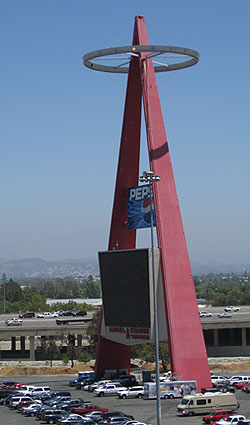 When Anaheim Stadium opened in 1966 it featured a 230-foot high letter "A" - complete with halo - that served as the main scoreboard's support.
When Anaheim Stadium opened in 1966 it featured a 230-foot high letter "A" - complete with halo - that served as the main scoreboard's support.
The 23-story, 210-ton sign stood behind left field until the stadium’s 1980 expansion necessitated its removal to the outskirts of the parking lot, some 1,300 feet away, where it has since become a Southern California landmark. When the stadium was being renovated back to baseball-only designers briefly considered moving the Big A back to its original location, before scrapping the idea due to costs. With a price tag of one million dollars the original cost of the Big A wasn't cheap either, but its construction was paid for by the Standard Oil Co. of California in exchange for advertising rights. Today, the Big A has an electronic marquee on one of its sides that displays ads to cars passing by on the Orange Freeway, while the halo is illuminated after an Angels victory.
Stadium Nickname
Ballpark HistoryThe Angels franchise began in 1961, playing their first season in Wrigley Field, a 20,500-seat minor league ballpark in Los Angeles that was home to the original Los Angeles Angels of the Pacific Coast League. When Dodger Stadium opened in 1962, the Angels signed a four-year lease with the Dodgers to use their stadium, which the Angels called Chávez Ravine Stadium during their tenure. For rent, the Angels paid 7.5 percent of gross attendance revenues. The Dodgers also received half of the Angels' concession gross and all parking revenues. Angels owner Gene Autry had no desire to play second fiddle to the Dodgers in Los Angeles, so he pursued a stadium for his team in the LA suburbs. The Angels almost found a home in Long Beach, but negotiations ultimately broke down when the city insisted the team had to be called the Long Beach Angels. Autry finally settled on Anaheim, which only had a population of 150,000 at the time, but was an attractive choice because 7 million people lived within 50 miles of where the stadium was to be built (on 140 acres of land previously occupied by four farms). Construction began on August 31, 1964 and, despite a work stoppage and strikes, Anaheim Stadium was completed in time for Opening Day in 1966 at a cost of $24 million. The stadium had an original capacity of 43,204 (but no outfield seats) when the newly renamed California Angels played the San Francisco Giants in an exhibition game on April 9, 1966. The first regular season game occurred ten days later against the Chicago White Sox. To accommodate the NFL's Los Angeles Rams, Anaheim Stadium underwent construction in 1979-80 that completely enclosed it and increased capacity for baseball to 64,593. The Rams made their debut on September 7, 1980, but left Anaheim for St. Louis following the 1994 season. The Angels played in the oversized multi-purpose facility for another two years before Disney took controlling interest in the team in 1996 and immediately decided to return the stadium to a baseball-only venue. Renovations to Anaheim Stadium began October 1, 1996 and seating capacity was reduced to 33,851 in 1997 while construction continued throughout the year. The extensive renovations cost $118 million, of which the Angels paid $88 million and the city of Anaheim $30 million. Included in the cost were earthquake damage repairs and replacing the stadium's multicolored seats with green seats. The renovations were completed in time for the team, then renamed the Anaheim Angles, to play the Yankees on April 1, 1998. By then, the stadium had been renamed to Edison International Field, after the California-based public utility holding company signed a $50 million, 20-year sponsorship deal on September 15, 1997. After the 2003 season, Edison International exercised its option to exit the sponsorship deal and on December 29 of that year it was announced that the city-owned stadium would be renamed Angel Stadium of Anaheim.
Location and ParkingBuilt near the intersection of three freeways, Angel Stadium is easy to access and spot. The stadium has a massive parking lot with 12,500 spaces. It’s cheaper, and easier to get back on the freeway after the game, if you park in one of the office complexes across the street from the stadium. A great option is the Orange County's Credit Union building on Orange Avenue, where it costs just $5 to park.
Game AtmosphereWhat a difference a World Championship makes! The Angels had never drawn three million fans in a season, but they’ve eclipsed that milestone every year since winning the World Series in 2002. I was at a game early in the ’02 season before the Angels got hot and the ballpark was mostly empty (attendance was less than 15,000), the place lacking any buzz. Those days are long gone. “It’s a baseball crowd now, way different than in the ‘90s, when people came because it was just something to do,” Angels pitcher Darren Oliver said in a 2007 Sports Illustrated article. The Angels’ average game attendance is near the stadium’s 45,050 capacity and their enthusiastic fans are decked out in red, the team’s color. The Angels have put a lot of emphasis on making the fan experience a pleasant one and they’ve succeeded in that mission. Game day staff is as friendly as the fan base and, unlike Dodger Stadium, it’s easy to move about the ballpark and watch the game from different sections.
The Rally Monkey "If you make noise, he will come" is spoken over the PA system and soon thereafter a monkey appears jumping around or holding a sign that says "Rally Time!!!" The pre-recorded video features Katie, the white-haired capuchin monkey that played Marcel on Friends. The video clip started as a joke on June 6, 2000, but after the Angels rallied that day to beat the Giants the Rally Monkey became a part of the Anaheim experience, at least when the Angels are trailing. And no matter the outcome of the game, stuffed versions of the monkey are a popular item in the team store.
TicketsAngels baseball is affordable. Plenty of good seats can be had for under $20 and even premium seat prices are reasonable. There’s no point in buying the “best available” at the box office, as ushers let you roam about. I even got into the club level, which is supposed to require a ticket, without any hassle. The bottom line is you get good value for your dollar in Anaheim, although it’s best to buy your tickets in advance as the team regularly sells out games.
Angel Stadium Footnotes - Facts & Figures
| ||||||||||||||||||||||||||||||||||||||||
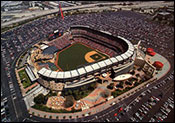
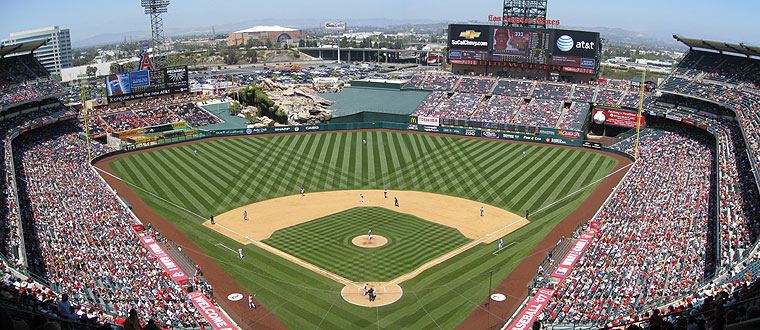
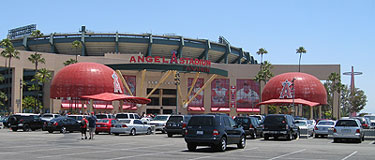 Nestled among freeways and office parks, the stadium is fully surrounded by parking lots on a 140-acre expanse of suburban land. The stadium’s beloved signature feature, the 230 foot high
Nestled among freeways and office parks, the stadium is fully surrounded by parking lots on a 140-acre expanse of suburban land. The stadium’s beloved signature feature, the 230 foot high 